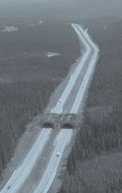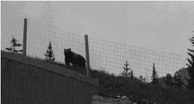Highways through habitats: The Banff Wildlife Crossings Project
| Topics: |
Contents
- 1 IntroductionBanff National Park and its environs in Alberta, Canada, are among the world’s best testing sites for innovative passageways to mitigate the effects of roads on wildlife. The major commercial Trans-Canada Highway (TCH) bisects the park, but a range of engineered mitigation measures—including a variety of wildlife underpasses and overpasses—has helped maintain large mammal populations for the past 25 years and has allowed the gathering of valuable data. (Highways through habitats: The Banff Wildlife Crossings Project)
- 2 Push for Research
- 3 Monitoring Results
- 4 Pilot Study
- 5 Effectiveness of Structures
- 6 Outreach and Education
- 7 Public–Private Partnership
IntroductionBanff National Park and its environs in Alberta, Canada, are among the world’s best testing sites for innovative passageways to mitigate the effects of roads on wildlife. The major commercial Trans-Canada Highway (TCH) bisects the park, but a range of engineered mitigation measures—including a variety of wildlife underpasses and overpasses—has helped maintain large mammal populations for the past 25 years and has allowed the gathering of valuable data. (Highways through habitats: The Banff Wildlife Crossings Project)
Push for Research
 The Trans-Canada Highway bisects the Bow River Valley, Alberta, a World Heritage Site. (Source: Tony Clevenger-WTI)
The Trans-Canada Highway bisects the Bow River Valley, Alberta, a World Heritage Site. (Source: Tony Clevenger-WTI) Less than 100 years ago, the first car to reach Banff National Park traveled a dusty, narrow road from Calgary. By the early 1970s, four paved lanes of the TCH linked Calgary to the park’s east gate. In the park, vehicles funnelled onto a two-lane highway section. As traffic increased, so did the accidents.
In 1978, therefore, Public Works Canada proposed “twinning” the highway—that is, expanding it to four lanes—from the east gate to the Banff town site. A second proposal followed, to twin the highway from Banff town site to the Sunshine Road. This provoked a debate, because many people believed that a larger highway would kill more wildlife and harm the park, but others argued that a larger highway would ensure safer travel for people. The debate was intense, but the effect of a larger highway on wildlife was studied more closely than ever before.
The first twinning project was approved with the goals of improving travel safety for people and of reducing the road kill of deer and elk. Highway fencing and the use of wildlife underpasses were recommended. At the time, however, the effects of a fenced highway on ungulates were not known. Information on where to locate the wildlife crossings, how many to create, or what kinds of underpasses deer and elk would use also was limited. Although sparse, the available data were assembled to guide the decisions. While the first twinning phase was in construction, the second was approved. The debate about highway twinning in the park continued, along with a push for scientific research and improved knowledge about the effects of roads on wildlife.
Monitoring Results
The TCH reconstruction included 24 wildlife crossings—22 underpasses and 2 overpasses—to ensure wildlife connectivity. Consistent evidence of the performance and effects of these crossings is needed to support implementation by transportation and resource management agencies. Although the installation of wildlife crossings is increasing, some organizations remain skeptical about the conservation benefits.
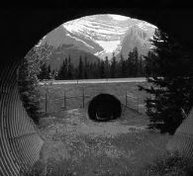 One of 22 wildlife underpasses constructed to mitigate the twinning of the busy Trans-Canada Highway in Banff National Park. (Source: Tony Clevenger-WTI)
One of 22 wildlife underpasses constructed to mitigate the twinning of the busy Trans-Canada Highway in Banff National Park. (Source: Tony Clevenger-WTI) In 1996, Parks Canada contracted for long-term research to monitor the Banff highway mitigation measures. Researchers have employed a variety of methods to monitor animal use of the wildlife crossings, such as regularly raking the track beds clean, deploying infrared-operated cameras, and checking the structures every three days year-round. The 10 years of project research are providing information about crossing structures at an unprecedented level of scientific rigor. Moreover, the research is being performed in an area that leads the world in the planning, design, and performance assessment of wildlife crossings.
Monitoring the track pads has shown that 10 species of large mammals have used Banff’s 24 crossings more than 84,000 times as of January 2007. The research suggests that the animals experience a learning curve—they need time to locate the wildlife crossing and to feel secure using the structures before crossing regularly. For example, grizzly bear crossings have increased from 7 in 1996 to more than 100 in 2006. Long-term monitoring demonstrates that the mitigation measures have reduced the traffic-related mortality of all large mammals on the TCH by more than 80 percent—a significant boost for maintaining viable wildlife populations.
Healthy, functioning ecosystems require viable wildlife populations. Knowing the effect of these crossing structures on the population levels, therefore, is critical. Although the structures should enhance population viability, no studies to date have addressed the related benefits.
Obtaining data on individuals in a population can be problematic, because wide-ranging, fragmentation-sensitive species like bears typically occur in relatively low densities and have low reproductive rates. Demonstrating that crossings provide population-level benefits—for example, allowing the movement of adult males and females across roads, as well as the dispersal, survival, and reproduction of the young—usually requires 15 to 20 years of intensive monitoring of radio-marked mammals.
Modern molecular techniques, however, have made it possible to identify individual animals, their sex, and genetic relatedness from only a few hairs. These innovations can provide a powerful, relatively inexpensive, and noninvasive way to acquire critical information about genetic interchange facilitated by crossings, without having to capture or see the animals.
Pilot Study
In 2004 and 2005, a noninvasive technique was pilot-tested for obtaining DNA from the animals using the wildlife crossings. With DNA obtained from an animal’s hair, researchers can create the equivalent of a genetic fingerprint. The unique DNA allows scientists to identify each individual and determine its sex and ancestry.
Sampling System
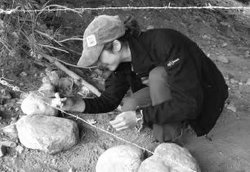 A two-strand system of barbed wire and sticky string was used to snag hair samples to yield DNA profiles of individual animals using a wildlife underpass. (Source: Tony Clevenger-WTI)
A two-strand system of barbed wire and sticky string was used to snag hair samples to yield DNA profiles of individual animals using a wildlife underpass. (Source: Tony Clevenger-WTI) A hair-sampling system was set up at two underpasses of the TCH in Banff. The system consisted of two strands of sticky string spanning the width of the underpass (see photo, right). Barbed wire was intertwined to enhance the efficiency of the system to obtain hairs with sufficient tissue for DNA analysis.
The target species were large carnivores, primarily bears; therefore the strands were suspended at 30 cm and 75 cm above the ground. Page wire and brush behind posts were used to funnel the animals toward the hair-sampling setup. Animal hair left on the barbs or on the sticky string was collected daily and sent to a laboratory to identify the species and the individuals within each species.
The hair-sampling systems also were monitored by video 24 hours a day to assess how the technique was working and to watch the wildlife responses to the slightly modified underpasses. The video footage allowed the researchers to identify and correct experimental flaws, as well as any negative effects on the wildlife.
Results
During the 2005 field season, carnivores made a total of 56 approaches to the two pilot underpasses; 43 of the approaches were by bears (24 black bears and 19 grizzly bears). Bears turned around or avoided the underpasses less than 10 percent of the time—two of the black bears and one of the grizzly bears approached but did not enter.
The success rate for hair capture was high for both bear species; more than 90 percent of the time, bears passing through the underpasses left hair—the grizzly bears left hair on 94 percent of their crossings. For both bear species, 81 percent of the hair samples yielded sufficient DNA for genetic profiling. Nine different bears used the two underpasses during the 31?2-month period in 2005: five grizzly bears (three females, two males) and four black bears (two females and two males).
Effectiveness of Structures
Following the success of the hair-snagging experiment, a three-year doctoral study at Montana State University was launched in 2006 to assess the population-level benefits of the Banff crossings. This requires collecting DNA from animals using the crossings to ascertain which individuals are contributing to gene flow and interchange between the populations separated by the TCH.
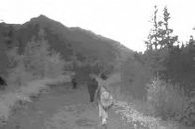 A wolf pack with pups, photographed by a remote-sensing research camera, traverses a wildlife overpass along the Trans-Canada Highway. (Source: Tony Clevenger-WTI)
A wolf pack with pups, photographed by a remote-sensing research camera, traverses a wildlife overpass along the Trans-Canada Highway. (Source: Tony Clevenger-WTI) The DNA data from hair samples of animals using the crossing structures will be compared with DNA data from a broader segment of the population, to provide a scientifically rigorous assessment of the conservation benefits of the Banff wildlife crossings. The results will help evaluate the effectiveness of the wildlife crossing structures in promoting genetic and demographic connectivity.
In addition, performance monitoring continues at all 24 wildlife crossing structures in Banff. The results will provide measurable data on the value of the different crossing structures in maintaining or restoring wildlife populations. The Banff research results have guided the design and location of 17 new crossings to be built in the latest phase of the TCH twinning project near Lake Louise—a prime example of yet-evolving science applied to inform transportation management planning. This experience and expertise should help raise international awareness and prove valuable for other regions worldwide.
Outreach and Education
The Banff Wildlife Crossings Project is sharing scientific findings through a mix of venues to inform the general public, students, and transportation professionals about the effectiveness of the 22 underpasses and 2 overpasses. The research has led to the following:
- Seventeen peer-reviewed scientific journal articles;
- Four graduate theses on the effects of the TCH on natural resources in Banff National Park;
- Two workshops for transportation professionals on mitigating the effects of highways on wildlife;
- The cover photograph on the fourth edition of Essentials of Conservation Biology, a popular collegetextbook by Richard B. Primack, published by Sinauer Associates;
- Field trips throughout the year for professionals and other interested individuals;
- A full-color poster produced as an outreach to kindergarten through high school classes;
- An exhibit at the Whyte Museum of the Canadian Rockies from May to October 2006, which informed more than 19,000 park visitors from around the world; and
- Extensive media coverage—television, radio, and print—with stories appearing in the New York Times, on the Canadian Broadcasting Corporation, and in many other media outlets across North America.
Public–Private Partnership
Since 2005, the research, outreach, communications and funding of the Banff Wildlife Crossing Project have been the result of a public–private partnership: a federal agency, a university transportation center, a nonprofit organization, and three North American conservation-based foundations. The partners include Parks Canada; the Western Transportation Institute at Montana State University; Friends of Banff National Park; and the Henry P. Kendall, Woodcock, and Wilburforce Foundations.
